Amsterdam is the capital of the Netherlands and one of the most popular and interesting tourist cities in Europe. This is an iconic city with its canals extending from a center in the form of a fan and its cute red brick houses lined up around it. The name of the city is mentioned with its colorful and interesting nightlife, however, even if you are not interested in the Red Light District, where this colorfulness revolves, it is an important candidate for the list of the first countries to see in your Europe trip, even with all its remaining features and beauties.
Known for its crazy and colorful nightlife, exquisite canals, fascinating museums, exquisite flower markets and endless cycling paths, Amsterdam is a northern city where the sense of fun and exploration does not stop at its streets. While it was a small fishing town in the 12th century, it now reveals a romantic and bohemian lifestyle with its cute houses, bicycle paths, and water channels that surround the city for miles.
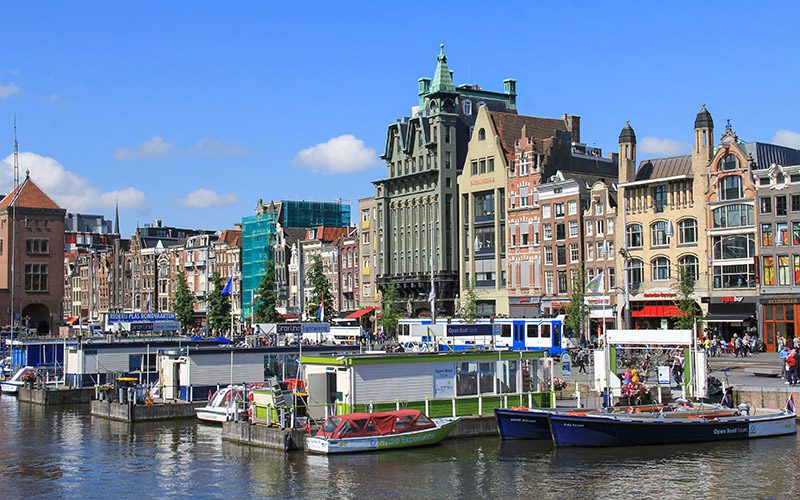
Amsterdam is one of the most visited cities in Europe with 4.5 million guests and 16 million daily tourists visiting its beautiful cobblestone streets every year. If you are wondering where all this popularity comes from when you see so many visitors and the number of people who fall in love with the city, take this charming city on your route, like me.
The city, which is often mentioned with red lights and green smoke, has much more than that. At least, I think so. I have had the opportunity to visit 2 times so far, and I plan to go every chance I get.
City of Freedom: Amsterdam Travel Guide
The establishment of Amsterdam, which is known as Amstel-reddamme due to its establishment on the banks of the Amstel River, dates back to the 1200s. The area, which came under the rule of the Dutch counts in 1296, grew into a city where Protestants and Jews took refuge in order to get rid of religious oppression within a few hundred years, and by the 1600s, it became a city where economic prosperity increased.
Amsterdam became one of the most important ports in the world in the 17th century, the Dutch Golden Age, the result of innovative developments in trade. So in the 19th and 20th centuries the city expanded further and many new neighborhoods and suburbs were added.
Its canals, with a total length of more than 100 km, most of which were arranged in the 17th century, give the city a very different and beautiful atmosphere. Amsterdam’s famous canals are on the UNESCO World Heritage List today.
Although Amsterdam is one of the smallest capitals in the world with a population of 800,000, it hosts guests from 180 different countries as the country’s tourism, culture, art and economy center. Everything you can expect from a city in one place Amsterdam is one of the most visited cities in Europe. If you only have a few days in the Netherlands, make Amsterdam your main purpose of the tour.
Amsterdam Attractions
1. Dam Square
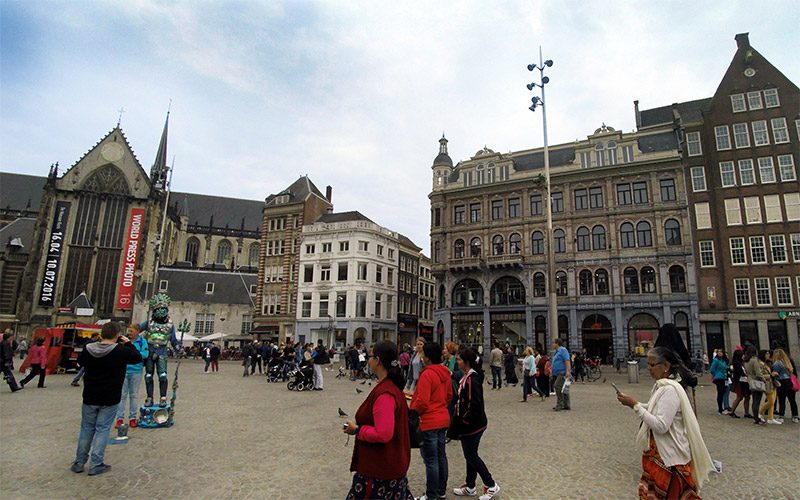
Dam Square is the heart of Amsterdam. It is very lively in both summer and winter. When you look around, you see tourists from all over the world. Skilled acrobats, musicians, lovers, prying eyes, photo shooters or backpackers enjoying the moment.
After a tiring city tour, it is a place where you might want to take a break with its pleasant ambiance. Of course, if you can find a seat from the crowd. Next to the square is the Royal Palace , which was used as the town hall in the 1600s . The Niewe Kerk (New Church) , a 15th-century gothic church next to the palace, which was converted into a Royal Palace in 1808, is an important building where coronation ceremonies were held.
On the other side of the square, the National Monument rises with a 22-meter-high obelisk. It was erected after the Second World War to commemorate the victims of war and as a symbol of freedom. 4 male figures representing war, a woman and a child representing peace, two men representing resistance and howling dogs are depicted alongside other symbols.
In the 11 vases buried in the obelisk, there is the land belonging to the provinces, and in the 12th vase, there is the Earth from the Onur cemetery in Indonesia. The monument is often used as a meeting point for people from all over the world.
2. The Royal Palace
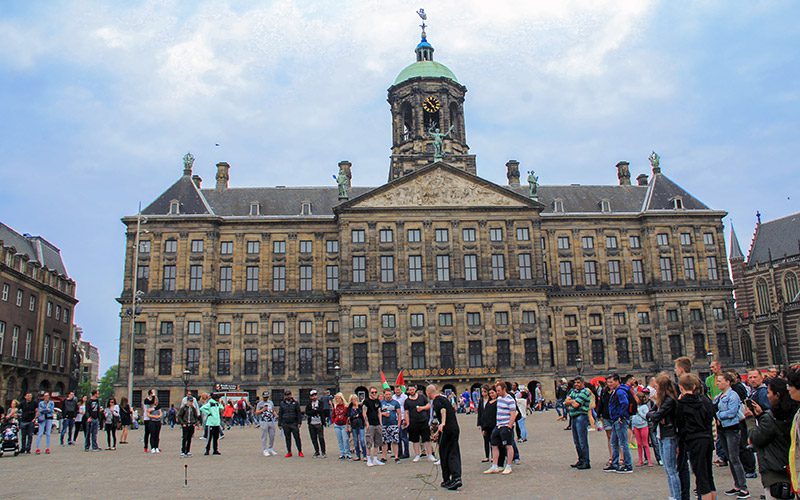
The Royal Palace serves as the residence used by the king when he comes to the city. It was built in Dam Square on a floor where 13,659 columns were sunk in 1648. While its exterior has a classical architecture emulating the Ancient Roman period, the interior is magnificently furnished.
Lots of reliefs, ornaments, marble sculptures, friezes and ceiling paintings by Rembrandt’s students Ferdinand Bol and Govert Flinck, and more. Travel if you have time. The palace can be visited between 10:00 and 17:00, 6 days a week except Mondays. Royal Palace entrance fee is 10€, student 9€.
3. Nieuwe Kerk
Nieuwe Kerk (New Church) is another important place in Dam Square. It has stood next to the Royal Palace as the official coronation church of the Dutch monarchy since 1814. Regular organ concerts are also held in this 15th century church. The most prominent place is the preacher’s pulpit built in 1649.
The figures symbolizing the four Gospel writers, faith, hope, philanthropy, justice and prudence are carved in magnificent Baroque woodcuts. See the 1670 organ, the uniquely beautiful bronze choir stage, and the elegant choir stools in the church. The church can be visited between 10:00 and 17:00, 7 days a week. Nieuwe Kerk entrance fee is 15€, 10€ for online purchases.
4. Amsterdam Canals
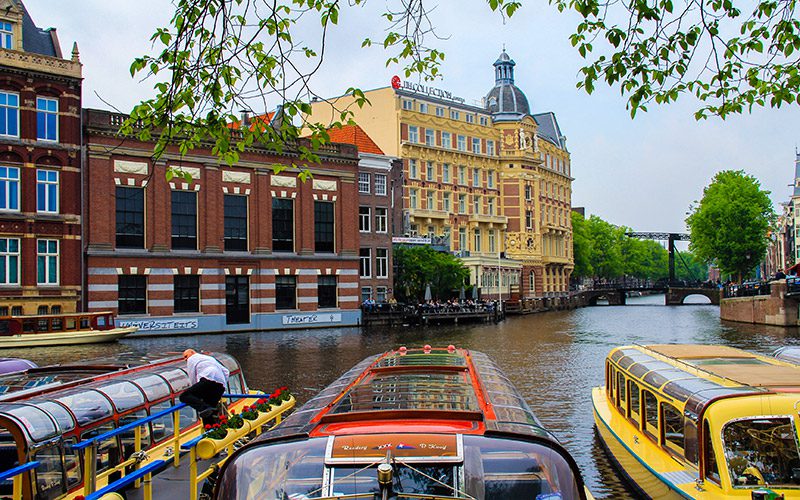

The Amsterdam Canals are one of Amsterdam’s most unique features. Amsterdam’s famous canals are a legacy from its glamorous and cosmopolitan past. Many bridges of unique beauty, which are on the UNESCO World Heritage List, connect the 90 islands of the city.
8 of them consist of old, wooden, scale-style bridges. The 16th and 18th century building with around 6750 magnificent architecture is crammed into 8 square kilometers with a total of 160 canals.
It creates a beautiful environment with the historical Dutch houses and water channels that you will see on canal tours. Among the bascule bridges, Magere Brug, that is, the Mager Bridge, is the most beautiful. Amsterdam Canal tours, attended by 3 million people a year, are one of the indispensable activities for tourists.
You find yourself on a journey through the beautiful architecture of Amsterdam. From short-term hop-on/hop-off taxis to luxury boats that offer drinks and meals to those who wish. Join someone that fits your budget. 1 hour canal tour 16€. Hop on-Hop off canal boat tour daily ticket 21€. Canal cruise with dinner costs 79€.
5. Red Light District
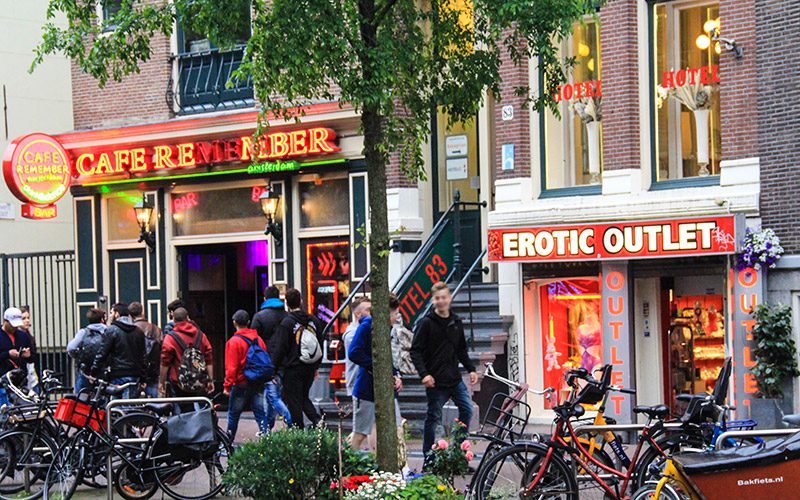
The Red Light District is a unique place with its many bars, sex shops, strip clubs and coffee shops, each with its own style, including three Bulldog Coffee Shops. In the region where pleasant canals and delicious cafes can be seen during the day, the whole event starts after 11:00 and continues until 03:00.
Almost everyone has different opinions or tolerance levels for De Wallen, better known as the Red Light District. While it may be thought that no one should have to sell their body for money, on the other hand, Amsterdam has managed to add some equity to an otherwise brutal industry. Minimum payments, legal protection, mandatory HIV testing and mandatory condom use are just a few of the improvements.
Whatever you think of the Red Light District, see the open display of prostitution just once to help you understand its reality. Of course, some people may spend a little more time here than others. Amsterdam nightlife isn’t just about the Red Light District, of course.
6. De Oude Kerk
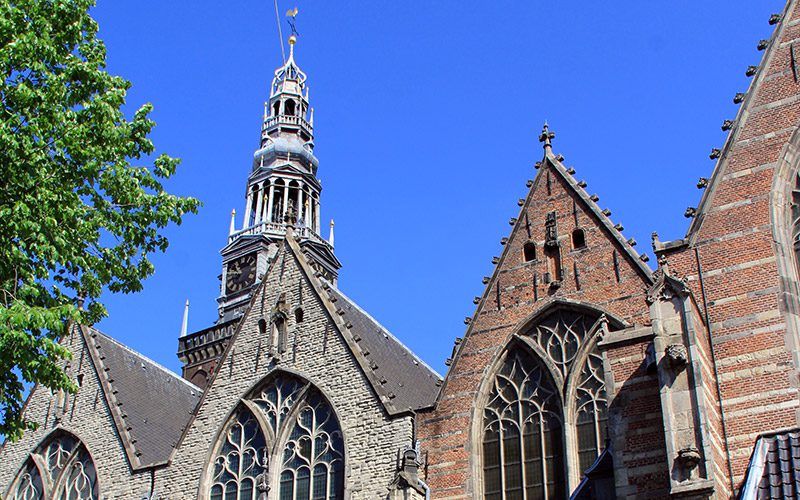
De Oude Kerk , or Old Church, is one of the oldest churches in the Netherlands. In the Old Church in the Red Light Distric, built in 1306, a door from the 1500s leads to the Iron Chapel, where many of the city’s concessions are kept locked, including the freedom tolls collected in 1275, documents show.
The tower, which was added in the 16th century and offers a wonderful view of the city, has a bell set built in 1658 and considered as one of the best examples in the country. The church can be visited 6 days a week, except Sunday, between 10.00-18.00 and on Sundays between 13.00-17.30. De Oude Kerk entrance fee is 15€, discounted ticket is 10€.
7. Zeedijk
Zeedijk is a colorful and fun street in the old center of Amsterdam. The street that is also one of the oldest embankments in Amsterdam. Here are the oldest walls, built at the end of the 13th century to protect the city against the numerous floods that ravaged the city. It was the most notorious place in the Netherlands in the 1980s. It’s been around since the beginning of Amsterdam.
It is now one of the most popular streets. It is also the heart of Chinatown with many cafes, restaurants and shops. You will find more than 70 monuments on the street. He Hua Temple, the largest Buddhist temple in Europe, is here. In the intermediate folds of Zeedijk, there are a number of gay cafes.
After visiting the De Oude Kerk church, take a 2-minute excursion across the bridge towards Zeedijk, one of the oldest streets in Amsterdam. It stands leaning against the vertical building No. 1 along the road, much of which dates from the 15th century and is considered the oldest surviving building in the city.
8. Rijksmuseum
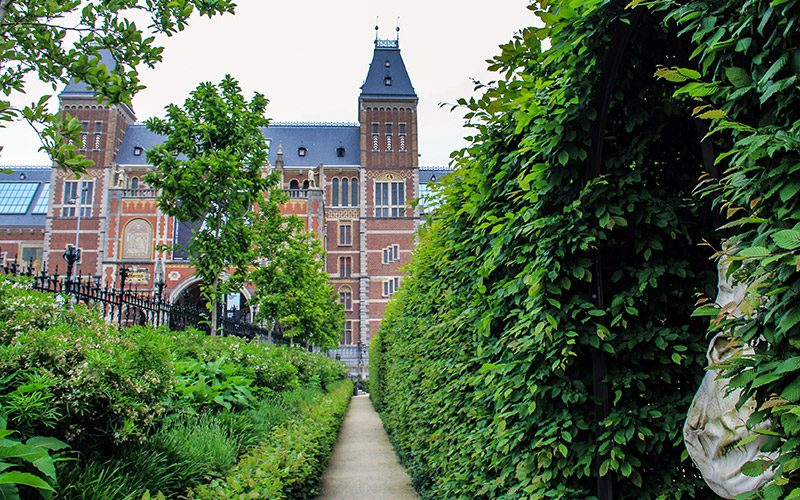
The Rijksmuseum is Amsterdam’s most important museum. Built by Dutch architect Pierre Cuypers in 1885 and reopened by Dutch Queen Beatrix in 2012, the Rijksmuseum exhibits the most important art collections of the Netherlands, such as 8,000 works of art, sculptures, ship models, antique objects, and local clothing.
Works by famous artists such as Rembrandt, Vermeer, Frans Hals and Jacob van Ruysdael are on display. In addition to its paintings, the Rijksmuseum deserves justifiably praise for its well-equipped library containing 35,000 books and manuscripts, as well as for its numerous exhibitions showing the development of Dutch art and culture. Seeing this place is one of the most popular touristic activities in Amsterdam.
One of the most valuable for Amsterdam Museums , add it to your list of places to visit. You need to spare at least 2 hours, if you are an art lover, even half a day is not enough. The museum can be visited 7 days a week between 09.00-17.00. Rijksmuseum entrance fee 20€, online ticket 19€, free for under 18s.
9. Van Gogh Museum
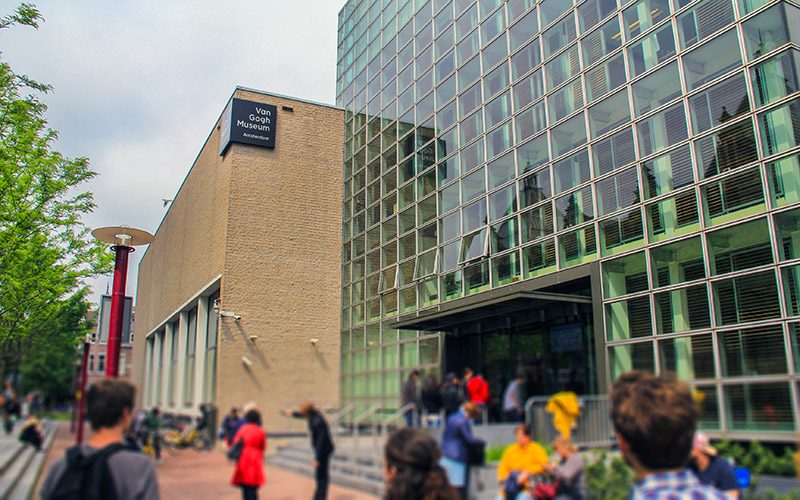
Van Gogh Museum is one of the most visited museums in the city. There are more than 200 paintings, drawings and letters of the Dutch artist Van Gogh, one of the world’s most famous painters. Whether impressed by his tragic life or his remarkable talent, around one and a half million visitors visit the magnificent Van Gogh Museum each year.
The museum is open from 09.00 to 17.00 from January 13 to March 19 (09.00 to 21.00 on Fridays), from 09.00 to 18.00 from March 20 to July 2 (09.00 to 21.00 on Fridays), from July 3 to August 30 from 09.00 to 21.00, from August 31 to 1 09.00-17.00 in the October period (09.00-21.00 on Fridays), 09.00-18.00 in the 2 October – 8 November period (09.00-21.00 on Fridays), 09.00-17.00 in the 9 November – 17 December, 09.00-19.00 in the 18 December – 10 January period It can be visited between hours.
Van Gogh Museum entrance fee is 19€. This price is valid for online purchases only. Since the museum has a very heavy visitor traffic throughout the year, I recommend buying tickets from the website in advance.
10. Anne Frank Museum
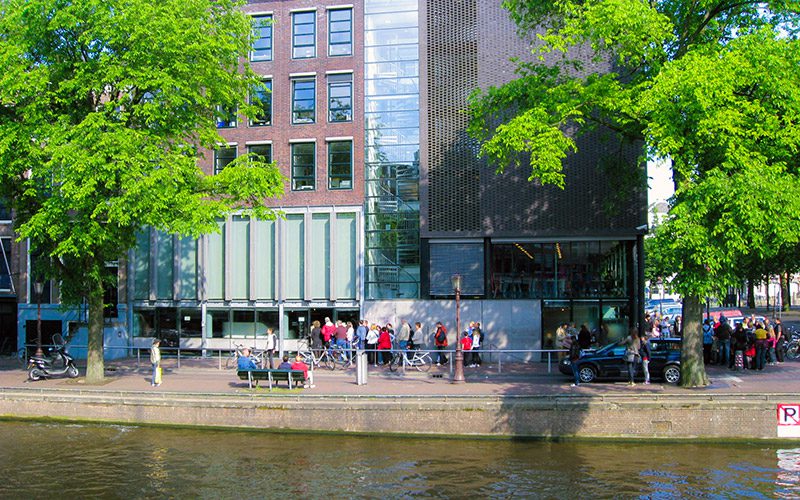
Anne Frank House , II. Dedicated to a Jewish girl who recounts World War II in her diaries. The building of the museum, which overlooks the Prinsengracht canal in Amsterdam, dates back to 1635 and belongs to a former merchant. Frank and Van Pels families, Jews who fled the Nazis in Frankfurt in 1942, hid in a secret apartment in this building for 25 months.
Anne Frank, one of the world’s most famous victims of the Nazi genocide, recorded her experiences in her diary during her hiding here between 1942-1944. It is here that Anne Frank wrote her diary, which has become a worldwide bestseller just a few years after her death at the age of 15. Much of the house can be visited as a poignant monument to this tragic period in history, preserved as it was during Anne’s lifetime.
The museum can be visited between 09.00-19.00 (09.00-22.00 on Saturdays) between November 1 and April 1, and between 09.00-22.00 between April 1 and November 1. Anne Frank House entrance fee is 10.50€, 10-17 years old 5.50€, 0-9 years 0.50€.
11. Westerkerk
Westerkerk (Western Church) is famous as the church where Former Queen Beatrix married in 1966 and is the most popular church in the city. It was built in 1630 as a Renaissance church with its Gothic architecture. Known as the Long John, the tallest structure in Amsterdam, its 85-meter tower is quite popular.
Inside the tower there is a bell set that tells the hours, and the bell hammer weighs exactly 200 kilograms, and the largest of the 48 bells is 3.25 tons. Rembrandt’s tomb, which was once located outside the church, was later moved inside the church.
The church can be visited between 11:00 and 15:00, 6 days a week except Sunday. Open on Saturdays from 10:00 to 17:30. Entrance to Westerkerk Church is free, Westerkerk Tower entrance fee is 7€. The tower can be visited between 10:00 and 19:30.
12. Begijnhof
Begijnhof is one of the peaceful places of the city center that many tourists do not easily notice while running from entertainment to entertainment. Unfortunately, this old and striking corner of Amsterdam does not find much place in the list of places to visit. Although many of the old houses are in use, the small alleys and roads surrounding them are open to the public. So feel free to explore.
Amsterdam’s last surviving wooden house since the 14th century and the well-kept green gardens of the city’s oldest houses are definitely worth seeing. In its small chapel, which is still in service, you can see the graves of the former residents of the area, the dark Catholic women who lived a communal life.
13. Rembrandt House Museum
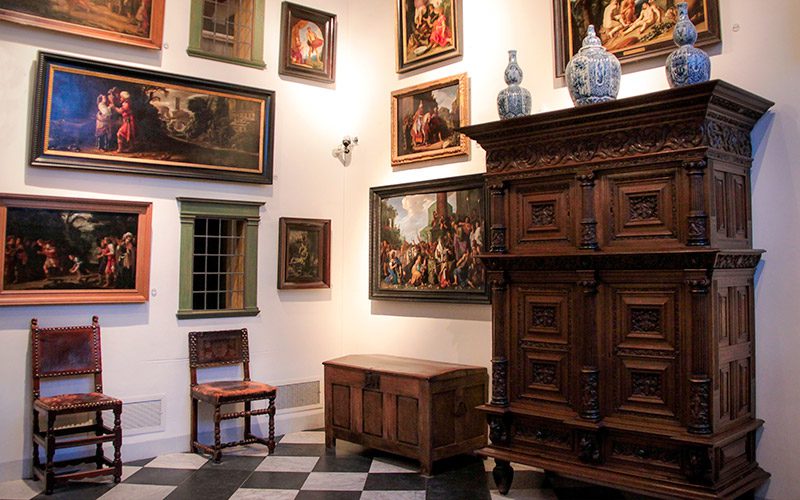
Rembrandt’s House Museum is located in the center of Old Amsterdam. It was created when the house where the world-famous Dutch painter Rembrandt lived between 1639 and 1660 was restored in 1906 and turned into a museum. Located a 15-minute walk from Dam Square, the museum has been welcoming visitors since 1909.
In the building, which is the home and workshop of the famous painter, there are approximately 250 works of drawings, sculptures and paintings, as well as personal belongings and tools he uses. All 290 engravings of Rembrandt are exhibited in the museum, which has been faithfully restored. If you are a museum lover, add it to your list.
A 2-minute walk from the Rembrandt Museum House, the Protestant Zuiderkerk Church (South Church) has the graves of Rembrandt’s three children and one of his students. Another Rembrandt-related attraction in the city is Rembrandt Square, which is famous for its numerous cafes and restaurants, as well as the statue of the famous painter.
The museum can be visited between 10:00 and 18:00, 7 days a week. Closed on April 27 and December 25. On the 24th and 31st of December, it closes at 17.00. On January 1, it opens at 11:00. Rembrandt’s House Museum entrance fee is 14€, 5€ for 6-17 year olds, free for I Amsterdam City Card holders.
14. Stedelijk Museum
The Stedelijk Museum (Amsterdam City Museum) was founded in 1895 and houses one of Europe’s most impressive collections of modern art. Focusing on 19th and 20th century, Dutch and French paintings, the De Stijl movement with examples from Van Doesburg, Mondrian and Rietveld; The museum, which highlights various famous art movements such as Pop Art with the works of Rosenquist and Warhol, also includes great painters such as Chagall, Dubuffet, De Kooning and Matisse.
It should be on the list of art lovers. The museum can be visited between 10:00 and 18:00, 6 days a week except Friday. On Fridays, it is open between 10:00 and 22:00. Stedelijk Museum entrance fee is 18.50€, student 10€, free for I Amsterdam City Card holders.
15. Heineken Experience
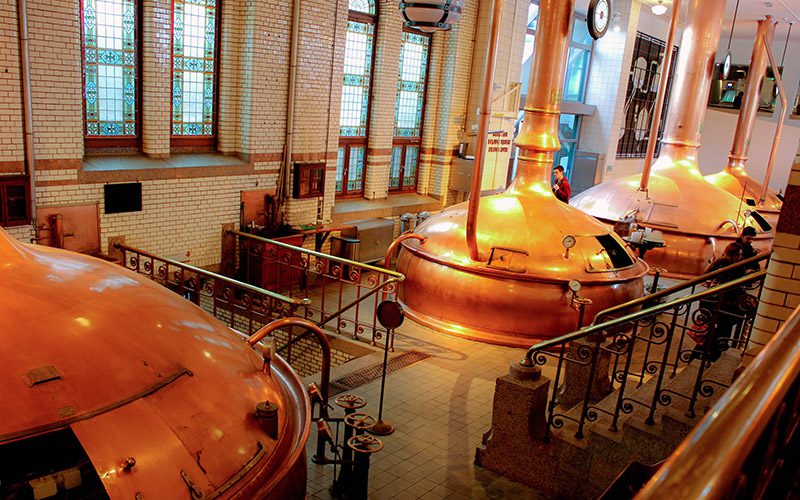
The Heineken Museum, which is actually an experience rather than a museum, and referred to as the Heineken Experience , is a kind of interactive museum where various entertaining presentations are made with Heineken, the country’s famous beer company. Used as Heineken’s headquarters until 1988, the building now offers information such as Heineken’s history and brewing. The museum, which is visited with great interest by tourists, also offers free beer.
The museum can be visited from Monday to Thursday between 10.30-19.30 (last ticket sale at 17.30, and from Friday to Sunday at 10.30-21.00 (last ticket sale at 19.00). It closes at 16.00 on December 24 and 31. Heineken Experience entrance fee is 21€, Ages 12-17 € 17.50. Online ticket purchases are discounted by €3.
Although Amsterdam is in the middle of the city, it never breaks away from nature. Vondelpark , one of the city’s most popular parks , is simply a place that promises peace. Amsterdam’s largest park, Vondelpark, receives more than 10 million visitors on the way. It should be on the romantic couples list.
The city’s botanical garden Hortus Botanicus Amsterdam is one of the oldest in the world. Less than 5 minutes’ walk from here, Natura Artis Astra is Amsterdam’s magnificent zoo in a shady garden lined with historic buildings with interesting animals from all over the world. Families with children can add to the list of places to visit.
To your list of places to visit in Amsterdam, the Port of Amsterdam , located in the bay formerly known as Ij, about 19 km inland from the open sea ; Particularly in the evening when the houses and bridges are illuminated, taking a boat tour in the harbor and canals is a place where you can spend an hour or two pleasantly.
Don’t forget to add the National Maritime Museum , which has an impressive collection of model ships, earth globes, navigation instruments and paintings in an old ship warehouse on Oosterdok. Nemo Science Center , a world-class science museum resembling the hull of a large ship, is a candidate for the list of attractions.
Amsterdam Nightlife
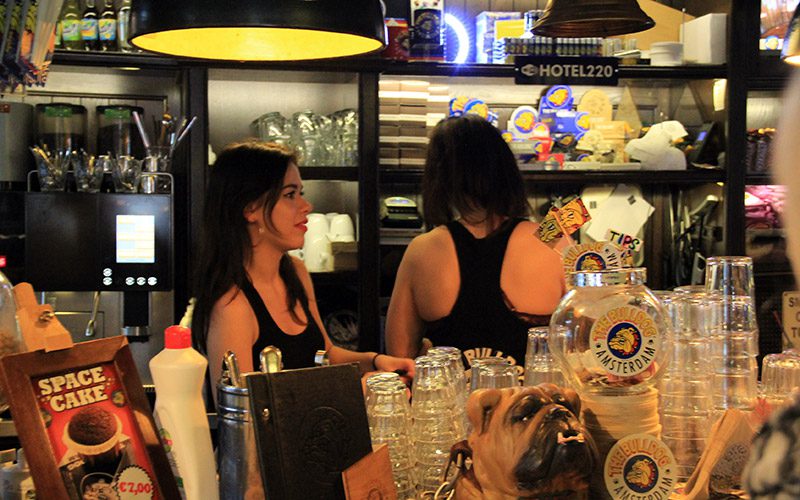
Many people visit Amsterdam for the choice and extreme nightlife. The two main areas of nightlife in Amsterdam are Rembdandtplein and Leidseplein and both have famous clubs. You can find more detailed information in my Amsterdam Nightlife blog post.
Amsterdam nightlife is long, lively and fun, not just the Red Light District. Especially for options such as cafes, bars, restaurants, nightclubs and discos, Leidseplein and Rembrandtsplein areas and the Jordaan region, which is famous for its cafes, which are an important part of Amsterdam culture, will be the right addresses.
Get advice from your hostel or hotel, too. In Amsterdam, the sale and use of soft drugs is free around cigarette coffee shops called “Coffee Shops”. These venues usually offer a cannabis menu with different types of potency.
Jim Woo : One of the most popular clubs in Amsterdam, Jimy Woo is always crowded. It is perfect for those who love to dance in impressive interior decoration and world-famous DJ performances.
Escape : Escape, which has been directing the nightlife of Amsterdam since 1987 with its capacity of two thousand people, is a very popular venue with multimedia, modern dance, visual and light effect shows, private parties, house, techno and progressive music and DJ performances.
Melkweg : Melkweg, a cultural center where concerts are held, theater and cinema screenings are held after the restoration of an old dairy factory, hosts different music events and party organizations as well as important concerts.
Studio 80 : Considered the best Techo-House in Europe, its venue starts to get lively after midnight. In Studio 80, which Amsterdam people call the Mecca of Electronic Music, electronic dance music does not slow down all night long.
Sugarfactory : Sugarfactory, a nightclub that brings together visual arts and music, is one of the best options for listening to groove and jazz. The place, which has been transformed by the restoration of an old sugar factory, is located opposite the Melkweg.
Trouw : The meeting point of vinyl lovers, Trouw is also a famous pub with the musicians it produces. The factory, where the Netherlands’ major newspapers were printed, now houses a nice restaurant and one of the craziest nightclubs in the city.
Air : The most popular venue of recent years for uninterrupted music, entertainment and dance, Air is seen as a must for Amsterdam nights.
Panama Club : It is a very special place where different styles, cultures, music and art meet, with a theatre, nightclub, bar, studio, cafe and restaurant.
Mazzo : Mazzo, the oldest nightclub in the city, is famous for its avant-garde video shows with a wide range of music such as house, latin, experimental electro.
Sinners in Heaven : Sinners, which has a different interior design, is a place with a predominantly R&B music style and plays different music on certain days of the week. With options such as DJ, Moulin rouge and disco, it offers Amsterdam residents excellent entertainment throughout the week.
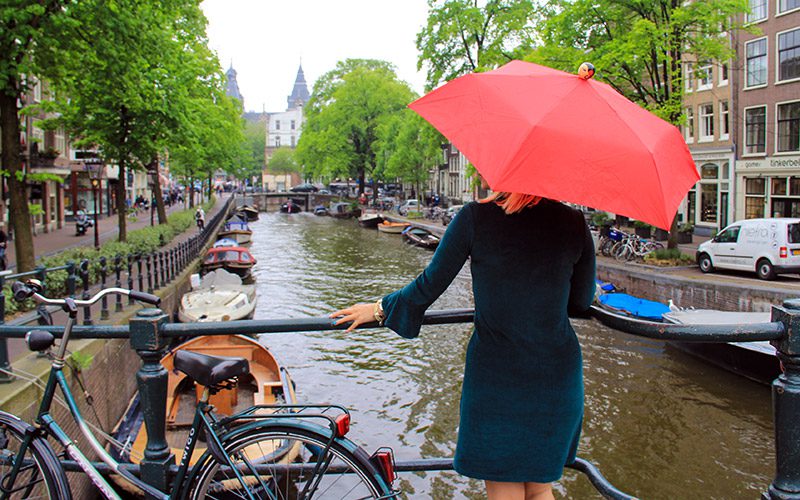
Paradiso : At Paradiso, Amsterdam’s most important disco, doors open every evening in jazz, fusion, latin, funk, garage, ska and deep soul disco styles. Depending on the performance to be exhibited at the box offices opened at certain times of the day, there may be a high demand. Paradiso is also a venue where names such as the Rolling Stones, Dawid Bowie and Prince give concerts.
Hotel Arena : Offering the happy crowd of the Arena, DJ, rock, house and techno-style entertainment, Hotel Arena is a place created by decorating a century-old church.
Ministry : Minstry, which has a small but cute atmosphere, is a popular place for lovers of different music styles, DJ performances, think speedgarage, 2 Step, and R&B classics.
Power Zone : The pub, located near the Amstel station with a capacity of five thousand people, is more of a ‘lounge’ place. The place, which draws attention with its interesting interior decoration and wide dance floor, is the number one address for young people.
Cafe’t Smalle : Cafe’t Smalle, one of Amsterdam’s old and nostalgic cafes, is a small and cozy cafe dating back to the 1780s. Let us remind you that the terrace is quite crowded in fine weather.
Alto Café : The café, which is perfect for those who want to listen to jazz music seven days a week, guarantees a wonderful time with the saxophone until 7 p.m. in the evening.
De Groene : Variety from 90’s rock songs to 2000’s house style, De Groene offers a quiet bar atmosphere for those looking for alternative entertainment.
Holland Casino : The biggest casino in Amsterdam, Holland Casino, is forbidden for anyone under the age of 18. Let us remind you that clothing and passport control is done at the gate of the casino, where entrance is paid.
Amsterdam festivals

Making strides in culture and art since the 19th century, Amsterdam fully embraces its title as an entertainment capital with its festivals, which not only Europe but also the whole world flock to. Hosting dozens of international festivals every year, Amsterdam appeals to all tastes, from single-day to weekly, from classical music to dance music, from art-house movies to theater or organic food festivals.
So much so that perhaps you can find more festivals in Amsterdam than the total festivals of our country. Amsterdam festivals, many of which are world-famous, attract millions of visitors each year to this vibrant and colorful city.
1. Pluk De Nacht: Pluk de Nacht, held between 5-15 August, is an important open-air film festival followed by the whole world. In this event, which lasts for 11 nights, many national and international films are screened.
2. Grachtenfestival Amsterdam: Held between 14-23 August, Grachtenfestival Amsterdam is a festival held on the canals of Amsterdam for classical music lovers. At the festival, which is attended by tens of thousands of people every year, you can witness a specially made performance in one of the magnificent houses by the canal.
3. KunstRAI: RAI, formerly known as Art Amsterdam, is a modern art fair held every May for five days. It is the most prestigious festival in Amsterdam, where painting, graphics, sculpture, jewelry, design and photography works are exhibited.
4. Mysteryland: Held between 29-30 August with its fairy-tale atmosphere, wide electronic dance music scale and creative activities, Mysteryland is regarded as one of the most interesting dance festivals in the world. The festival, where you can witness the best examples of dubstep, hip hop, disco, house and techno music, has been held for 21 years.
5. Kwaku Summer Festival: Kwaku Summer Festival, which takes place over four consecutive weekends between July 18 and August 9, is held at Nelson Mandelapark every weekend with a different theme. The festival, which aims to provide cultural interaction by bringing people from different cultures together, is a festival worthy of the free spirit of Amsterdam, which has been going on for more than forty years and is attended by around 300 thousand people every year.
The 6th Stichting Imagine Film Festival: Held every year in April, the festival hosts many screenings from horror films to anime, from cult films to science fiction.
7. Holland Festival: Holland Festival , the largest cultural event festival in the Netherlands, hosts many performances from opera, theatre, dance and ballet to music. Various conferences and workshops are also held during the festival.
8. The Uitmarkt: The Netherlands’ biggest cultural festival, Uitmarkt is held every year during the last weekend of August. The program, in which more than 2000 artists take the stage, includes not only concerts, but also numerous workshops such as musicals, exhibitions, performances and art studios.
The 9th ITs Festival: Held every June, the International Theater Festival (ICT) is an international festival with actors, dancers, mime artists, film directors and other performance artists, as well as Europe’s largest student festival packed with lectures and workshops.
Eating and drinking in Amsterdam
It is possible to find almost all of the world cuisines in the city, which hosts many people from different geographies of the world. Italian, Turkish, Arab, French, Indian, Chinese, Ethiopian, Russian, Japanese, Greek, Iranian and Latin American flavors are spread all over the city. If you want to taste interesting tastes, stop by Febo. Taste waffles, people watch in the square while you eat your french fries.
Amsterdam’s diversity is also reflected in its diverse restaurants. There are plenty of Asian restaurants, falafel bars (Everywhere!), Surinamese cuisines, and places like Eatcafe serving late-night meals galore. You can also find the usual tourist bars and restaurants; some great, some not so much.
There’s a lot of waffle and ice cream stands, so if you’re a sweet or snack lover like me, it’s fine! Try real Dutch cheese and check out the sausages, cured and cured meats at the supermarket.
Stay away from the burgers in the “fast food” machines in the form of slot machines hanging on the wall, after a while all the interestingness disappears when you realize that you are eating garbage. But the flavors are good and the prices are reasonable.
shopping in Amsterdam
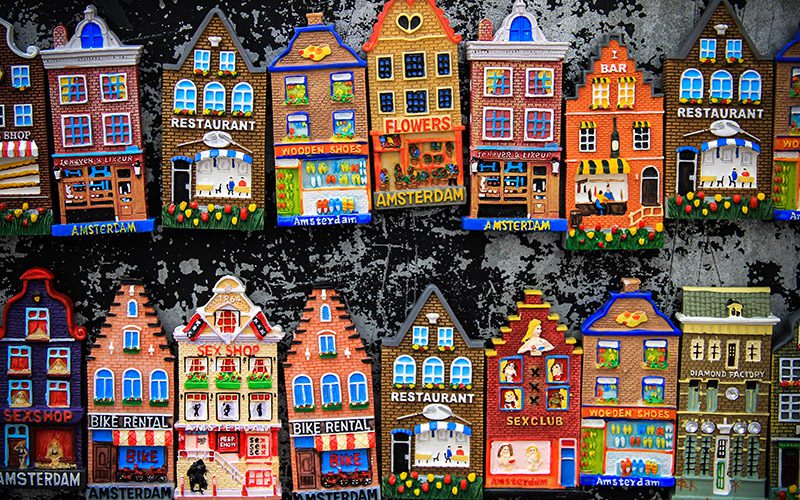
Amsterdam has all the shopping possibilities you would expect from a European city. Numerous market places are extremely cute options for a pleasant shopping trip. Look for markets in different parts of the city that showcase the ethnic diversity and often have large discounts.
Albert Cuypmarkt in Pijp District is one of the best known. Head to Amsterdam’s flea market, the Vlooienmarkt, which has been established since 1886. Many more flea markets, organic food markets, antique stalls and of course the famous Flower Market are here again.
The Floating Flower Market , located on the Singel Canal and organized as a floating market with its flawless beauty , is a colorful and lively region with various beautiful flowers. There are gift baskets with lots of tulips here, a really nice souvenir of Amsterdam.
Most of the best shopping streets are scattered around Muntplein Square, which was used as a sheep market in the 15th century. The most famous shopping street in Amsterdam is Kalverstraat, which runs parallel to the main street Damark, which runs from the train station to Dam Square. Dam Square is also home to the flagship store of the prestigious Beijenkorf retail chains.
When to go to Amsterdam
The typical Dutch climate prevails in Amsterdam, in short, it is not known when or what will happen. You are lucky if you can see the blue sky. The second time I went, while the weather was normal, it rained heavily for the next 2 days, and I was lucky to be one of those who could see the blue sky the next day.
Warm days a little above 20 degrees in summer await you. But be prepared to face rain, wind and cold outside of summer. Spring is a good time to visit Amsterdam, when the weather is generally dry and sunny and you can avoid the summer crowds. Although the days are a little shorter, around October is also a good time.
Amsterdam hotels
Amsterdam is a popular city visited by millions of people every year. Therefore, it is very easy to find accommodation suitable for every budget in and around the city.
One of Amsterdam’s most recognizable landmarks is the Flying Pig, with one of its three branches located on a beach close to the city. Although there are many places in the city, The Flying Pig Downtown Hostel is one of the most preferred places for young backpackers. Budget Hostel Heart of Amsterdam hostel located in Red Light Dsitric is also very nice.
Hostel prices start from 15 Euros per night and can go up to 90 Euros on the weekends of the summer season. You read that right, for a hostel! Although simple, breakfast is served in almost all of them. 1-2 star hotels have almost the same prices.
If you’re looking for a little more luxury, Amsterdam offers plenty of options for accommodation, with over 400 hotels ranging from 1-2 star ones to the most expensive hotels in Europe.
In addition, 5-star hotels are between 150 and 400 Euros per night. The 4-star NH Amsterdam Schiller hotel, where I stayed in my last visit, is a very nice hotel, away from the hustle and bustle of the city and a 15-minute walk from the center of Amsterdam. There are many cute cafes and bars in and around Rembrandtplein Square. Early booking is absolutely essential, especially in the summer months. It’s also a good idea to rent a house with Airbnb .
How to get to Amsterdam
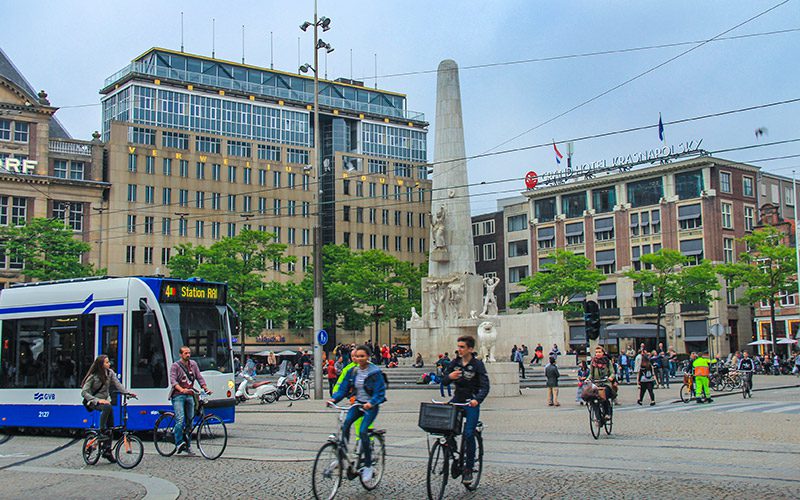
Amsterdam Schiphol International Airport is one of Europe’s major transit hubs, with hundreds of flights from almost all over the world, and is located 17.5 kilometers southwest of the city centre. Amsterdam central station is easily reached by a 20-minute train ride. Turkish Airlines, KLM, Atlas Global, Onur Air and Pegasus organize direct flights.
Click on the “How to get to Amsterdam” link in the title , and I have shared detailed information on how to get from the airport to the center of Amsterdam. If you are thinking of going here from another city in Europe, there are numerous flights and very good rail connections. I once traveled to the Netherlands in the form of Rotterdam outbound and Amsterdam return.
Also check nearby airports to go cheaper. Maximum 1 hour from cities such as Utrecht, Rotterdam and The Hague. You can find detailed information on how to get to Amsterdam in my blog post.
Central Station is directly connected to Shiphol Airport by train. Afterwards, I say walk to explore the city. If you plan to spend a lot of time in the city center, a bike is much more fun. The very useful tram, bus and metro system makes transportation in Amsterdam extremely easy.
Cycling certainly makes things a lot easier on crooked and diagonal streets. There are numerous small shops, some of them large and some large ones, where you can rent bicycles around tourist attractions such as the Central Station, Leidseplein and Dam Square.
The Amsterdam travel guide has become one of the longest blog travel guide content I have ever written. If I write all my information about Amsterdam, I think it will be 3-5 times that. Check out other posts on the blog about Amsterdam . Or never mind, throw yourself into the streets of this red brick city, just listen to your inner voice. Amsterdam is a really beautiful city.













